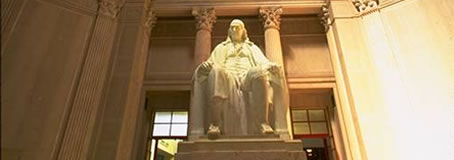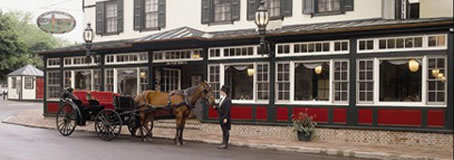From the Strategic to the Tactical: Four Experts Offer Advice
09-24-2006
Law firms and the professionals who help market them face a wide range of challenges and opportunities. These issues range from strategic (such as positioning or branding) to tactical (such as honing better presentation skills). At a September 26 program hosted by Reed Smith LLP, members of the Delaware Valley Law Firm Marketing Group heard four experts expound for 10 minutes each on issues that local firms and their marketers deal with every day.
Positioning Your Brand
Martin McLaughlin of Mosaic Partners noted that law firms compete in a very fragmented market: the United States has 250,000 law firms: 900 with more than 50 lawyers; 22 percent with four to 49 lawyers; and 76 percent with fewer than four lawyers.
Firms also are facing an increasingly competitive landscape. The Fortune 1000 companies are working with fewer firms. According to published reports, companies will reduce the number of firms used from an average of 75 to fewer than 40 in 2006. Businesses are consolidating, resulting in fewer clients and more competition for legal work.
How can firms differentiate themselves? Client service often is not segmented or prioritized among clients. Lawyers/law firms often don’t understand buyers’ needs. Practice groups are emerging as the driver of work and profits; firm-wide knowledge is not shared or used. Branding is tactical, often driven by marketing, not strategic, McLaughlin said.
Law firms must understand where they capture value, he said. For example, in many firms 10 percent of clients generate 70 percent of revenue; 20 percent of clients generate 80 percent of revenue; and 50 percent generate 97 percent of revenue. Law firms must know their buyer and communicate in a tailored fashion how the service is (and must be) different for different buyers. This is especially true for services perceived as a commodity, he said. Firms that have good client relationship management (CRM) systems should take advantage of the information in them to find out which clients provide the most value to the firm. Firms that don’t share that information will miss opportunities to target services, he said.
McLaughlin said law firms must ask: who are we; what do we do; who are our target clients; what do clients want; what are clients’ needs; why do clients work with this firm and not another firm; can everyone in the firm communicate the "brand?"
McLaughlin also encouraged the audience to read Fred Reichheld’s book, The Ultimate Question: Driving Good Profits and True Growth. The book describes how firms turn customers/clients into promoters (published by Harvard Business School Press, 2006).
Presentation Skills
Pitching for business is a learned art. One of the most valuable skills for any professional in marketing is effective presentation skills. Former television reporter Jill Chernekoff, now a public speaking consultant and coach, commented that every time we talk with someone outside our own homes, we are making a presentation. To overcome the fear nearly all of us have about public speaking, we need to avoid the "noise" in our heads – the doubts we have that prevent us from communicating effectively. Her tips:
-
Speak to express, not to impress. Forget your ego; identify with your audience’s struggles.
-
Be authentic. Tell the truth, speak from the heart; be real; speak on what you know. Get real to connect with your audience. Use "I" phrases, not "you" phrases – using "you" creates a gap between speaker and audience. Lose the need to be right.
-
The number one goal of any presentation is relatedness – it’s how you connect with your audience.
-
Show that you care – talk with the audience to learn what they care about.
-
Know what your "elevator" speech is – who you are, what distinguishes you from others, what you do, what problem you solve. Your goal is to create connectedness – leave them wanting more.
-
Maintain eye contact. Talk to individuals within the group/audience. Be sure to wear your nametag on the right side, where it’s easier to read when shaking hands.
-
Know your PAL: Purpose; Audience; Logistics. Arrive early for meetings/speeches; get to know the AV person, etc. If you use PowerPoint, remember that you are the "power" – know how to use it correctly.
-
It’s all about THEM – the audience, the other person, who’s asking, "What’s in it for me?"
-
Prepare, don’t wing it. If you are prepared, you will look like you’re winging it. Practice your speech/presentation. Written language is different than spoken language; presentations are for the ear, not the eye.
-
Have a strong closing segment, a call to action. Define what you want your audience to do and say when they leave.
Event Management
Successful events require good planning, according to Carolyn MacKinnon of Dechert LLP. She advised holding a planning meeting as early as possible with key players, to set the objective and manage expectations. At the meeting, develop the topic, review past event evaluations and outline all program details. Develop a timeline, define responsibilities and deadlines, and target your appropriate audience. Review mailing lists to develop and refine your audience.
Plan the type of event – what tone do you want to project? Select the location/venue; decide on the room set-up; food/beverages; invitations; Web site (if needed); communications within firm to reinforce the type of event.
Next, get the word out. Consider sending a pre-event promotion to media and industry association calendars. Send a "save the date" announcement to the potential audience and ask for their input on topics using a questionnaire. Promote the event internally.
MacKinnon recommended having a "Day of Event" box for supplies, such as name tags, pens, tape, scissors, paper, giveaways, signs and the like. The day before an event, do a run through. Review the set up one last time and review final attendance lists. The day of the event, arrive early; breathe and smile.
Follow-up is critical to the success of an event, MacKinnon said. Analyze attendees and which lists worked well; review evaluations; help lawyers reach out for follow up contact; evaluate the budget; track new business replicas breitling that might be attributed to the event; share the positive comments as well as the suggestions for future improvement; and incorporate all into future event planning.
Take advantage of the experience you gained with a successful event by recycling it – take it on the road to other offices, offer it to clients as an in-house program or to industry associations; or seek co-sponsors to offer to a new audience, MacKinnon suggested.
Optimizing Press Opportunities
Good PR opportunities rarely just happen – you have to pick the right story to promote, according to Joshua Peck, senior media relations director at Duane Morris LLP.
To find the right story, walk the halls of the firm, Peck said. Ask lawyers what’s new. You’re looking for an insight – "I didn’t know that" – that will interest a reporter. Whatever the story is, it can’t be boring.
For each story, find, or build, a great spokesperson with good presentation skills, he said. It’s not necessarily the most senior person on the case – it’s got to be someone who can connect with the reporter.
Find the right publication, one that clients read. You need to know the publication, its style of writing, its reporters and what they cover. Prepare a catchy statement – a distinguishing fact – to get the reporter engaged. Peck said. Be prepared for the pitch to take time; be persistent. It may take many calls before the reporter is interested.
Promote the story after it’s been printed, he said. Order reprints, put it on your Web site and circulate it within the firm.
This article was written by Mary Beth Pratt of MBPratt Consulting, who has more than 20 years of experience in law firm marketing. | 










